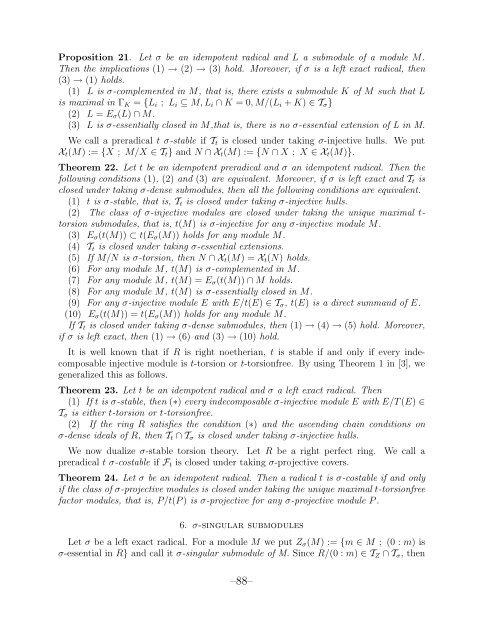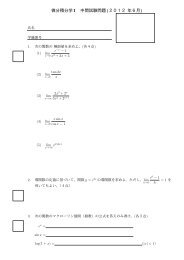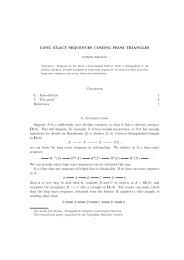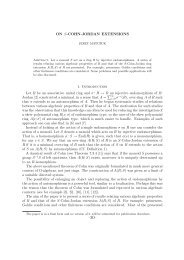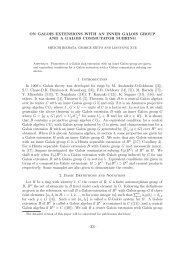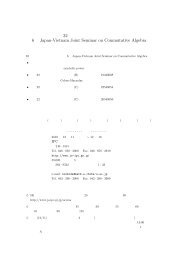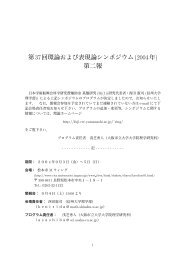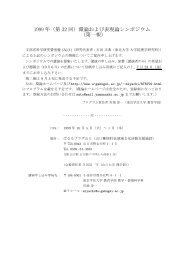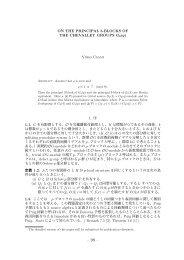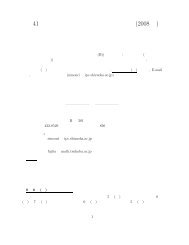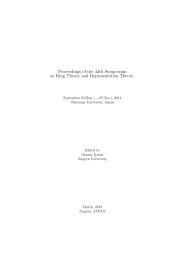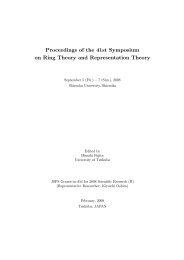Yasuhiko Takehana - FUJI
Yasuhiko Takehana - FUJI
Yasuhiko Takehana - FUJI
You also want an ePaper? Increase the reach of your titles
YUMPU automatically turns print PDFs into web optimized ePapers that Google loves.
Proposition 21. Let σ be an idempotent radical and L a submodule of a module M.<br />
Then the implications (1) → (2) → (3) hold. Moreover, if σ is a left exact radical, then<br />
(3) → (1) holds.<br />
(1) L is σ-complemented in M, that is, there exists a submodule K of M such that L<br />
is maximal in Γ K = {L i ; L i ⊆ M,L i ∩ K =0,M/(L i + K) ∈T σ }<br />
(2) L = E σ (L) ∩ M.<br />
(3) L is σ-essentially closed in M,that is, there is no σ-essential extension of L in M.<br />
We call a preradical tσ-stable if T t is closed under taking σ-injective hulls. We put<br />
X t (M) :={X ; M/X ∈T t } and N ∩X t (M) :={N ∩ X ; X ∈X t (M)}.<br />
Theorem 22. Let t be an idempotent preradical and σ an idempotent radical. Then the<br />
following conditions (1), (2) and (3) are equivalent. Moreover, if σ is left exact and T t is<br />
closed under taking σ-dense submodules, then all the following conditions are equivalent.<br />
(1) t is σ-stable, that is, T t is closed under taking σ-injective hulls.<br />
(2) The class of σ-injective modules are closed under taking the unique maximal t-<br />
torsion submodules, that is, t(M) is σ-injective for any σ-injective module M.<br />
(3) E σ (t(M)) ⊂ t(E σ (M)) holds for any module M.<br />
(4) T t is closed under taking σ-essential extensions.<br />
(5) If M/N is σ-torsion, then N ∩X t (M) =X t (N) holds.<br />
(6) For any module M, t(M) is σ-complemented in M.<br />
(7) For any module M, t(M) =E σ (t(M)) ∩ M holds.<br />
(8) For any module M, t(M) is σ-essentially closed in M.<br />
(9) For any σ-injective module E with E/t(E) ∈T σ , t(E) is a direct summand of E.<br />
(10) E σ (t(M)) = t(E σ (M)) holds for any module M.<br />
If T t is closed under taking σ-dense submodules, then (1) → (4) → (5) hold. Moreover,<br />
if σ is left exact, then (1) → (6) and (3) → (10) hold.<br />
It is well known that if R is right noetherian, t is stable if and only if every indecomposable<br />
injective module is t-torsion or t-torsionfree. By using Theorem 1 in [3], we<br />
generalized this as follows.<br />
Theorem 23. Let t be an idempotent radical and σ a left exact radical. Then<br />
(1) If t is σ-stable, then (∗) every indecomposable σ-injective module E with E/T(E) ∈<br />
T σ is either t-torsion or t-torsionfree.<br />
(2) If the ring R satisfies the condition (∗) and the ascending chain conditions on<br />
σ-dense ideals of R, then T t ∩T σ is closed under taking σ-injective hulls.<br />
We now dualize σ-stable torsion theory. Let R be a right perfect ring. We call a<br />
preradical tσ-costable if F t is closed under taking σ-projective covers.<br />
Theorem 24. Let σ be an idempotent radical. Then a radical t is σ-costable if and only<br />
if the class of σ-projective modules is closed under taking the unique maximal t-torsionfree<br />
factor modules, that is, P/t(P ) is σ-projective for any σ-projective module P .<br />
6. σ-singular submodules<br />
Let σ be a left exact radical. For a module M we put Z σ (M) :={m ∈ M ; (0 : m) is<br />
σ-essential in R} and call it σ-singular submodule of M. Since R/(0 : m) ∈T Z ∩T σ , then<br />
–88–


